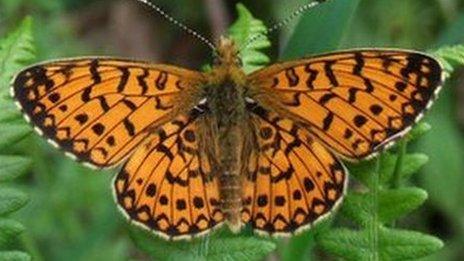Clocaenog's pearl-bordered butterfly population rises
- Published

Numbers of the small pearl-bordered fritillary are on the increase again in Clocaenog Forest.
Conservationists have reversed the decline of a specie of butterfly in Clocaenog Forest, Conwy.
The population of small pearl-bordered fritillary plummeted last year to 1,200 from 2,400 in 2003.
But the Forestry Commission Wales (FCW) and Butterfly Conservation Wales (BCW) improved its habitat and the population has now increased.
Conservation officer Clare Williams said the butterfly is now better understood.
The fall in population prompted the FCW and BCW to put an urgent management programme in place.
Contractors were brought in to clear the equivalent of eight rugby pitches worth of scrub and conifer along more than a three-mile stretch of rivers and streams in the forest and creating sheltered, open habitats with marsh violet, the caterpillar's food, which the butterfly could use for breeding and feeding.
The FCW's manager for the Clocaenog area, Mike Whitley, said the forest was a huge area that was home to a great variety of habitats and species.
"It's great to see this rolling programme of conservation work benefiting many different species, in particular the small pearl-bordered fritillary," he said.
Legal protection
The butterfly is identified as a "species of principal importance" in Wales, under the Natural Environment and Rural Communities Act. This means it needs conservation action to prevent populations declining any further.
It can mainly be found in Wales and Scotland but numbers have fallen dramatically in the lowlands and in woodlands.
Ms Williams, from the BCW, said: "We are very pleased to be working with Forestry Commission Wales on this long running research project.
"It has helped to improve our understanding of how the butterfly responds to forest management at a landscape scale. It's great now to be able to use this research to guide successful management to help ensure the continued survival of this beautiful butterfly."
The steady decline of the butterfly in Clocaenog was recorded over the last 11 years.